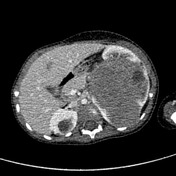Beckwith-Wiedemann syndrome
Updates to Article Attributes
Body
was changed:
Beckwith-Wiedemann syndrome (BWS) is a congenital overgrowth disorder characterised by a unique set of features that can consist of:
- macroglossia: most common clinical finding 4
- otic dysplasia ref
- omphalocoele
- localised gigantism / macrosomia
- hemihypertrophy
- cardiac anomalies
- pancreatic islet cell hyperplasia
- organomegaly
Epidemiology
The incidence is reported at ~1:13,000-37,000 live births.
Pathology
The majority of cases are sporadic while a small proportion (~15%) is autosomal dominant with abnormality related to chromosome 11p15.5. The syndrome carries a well recognised increased risk for the development of neoplasia 4. Another 10-20 of cases show paternal disomy 11.
Associations
- Wilms tumour(s) 1
- polyhydramnios
- non-malignant renal diseases 3
- premalignant renal diseases
- adrenocortical carcinoma
- gonadoblastoma
- rhabdomyosarcoma
- neuroblastoma
- pancreatoblastoma
- hepatoblastoma
- placental pathology
- postnatal hypoglycaemia
- genitourinary anomalies
History and etymology
First described independently by JB Beckwith in 1963 and H-R Wiedemann in 19651964 6,7.
-</ul><h4>History and etymology</h4><p>First described by <strong>Beckwith</strong> and <strong>Wiedemann</strong> in 1965.</p>- +</ul><h4>History and etymology</h4><p>First described independently by <strong>JB Beckwith</strong> in 1963 and <strong>H-R Wiedemann</strong> in 1964 <sup>6,7</sup>.</p>
References changed:
- 6. Beckwith JB. Extreme cytomegaly of the adrenal fetal cortex, omphalocele, hyperplasia of kidneys and pancreas, and Leydig‐cell hyperplasia: Another syndrome? (1963) Abstract, Western Society for Pediatric Research.
- 7. Wiedemann H‐R. Complexe malformatif familial avec hernie ombilicale et macroglossie, un “syndrome nouveau.” (1964) J Genet Hum 13: 223–232.
Images Changes:
Image 5 CT (C+ portal venous phase) ( update )

Caption
was changed:
Case 3: Beckwith Wierderman with bilateral Wilms tumours







 Unable to process the form. Check for errors and try again.
Unable to process the form. Check for errors and try again.